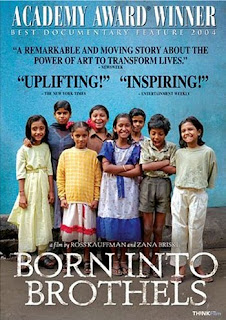
Imagine being brought up in the filthiest alleys of a red light district, where days begin with lurid screams from drunken men and women. Imagine a childhood where you toiled from dawn to dusk, filled buckets with water, scrubbed dirty pots and pans, and watched your family fight and curse at each other. On some days you carried booze bottles to your mother’s guests, on other days you clasped your ears to shun the sounds that came from a room next door. For most of us, who have lived a secure life, it is difficult to imagine a childhood smeared with obscenity, fear and a lot of anguish.
The Daily Star link July 13, 2010
But there are children out there whose first day into this world marks the beginning of a tormented life. “Born into Brothels” is a bold attempt to bring into light the lives of children growing up in the notorious Sonagachi brothel of Kolkata. Some of the shots are heart-breaking; some of the scenes make you contemplate what it would be like to grow up in an environment, where crimes and filth abound. Very few of us look into these children’s lives, their past and their stories. What most of us do is label them as an unwanted, unacceptable burden on the society. The film is old but its messages are not.
Made in 2004, Born into Brothels is a documentary film that talks about Puja, Avijit, Suchitra, Kochi, Manik, Shanti and their friends, and how they gradually become engrossed in photography. Their tutor was Zana Briski, an American photographer who came to Sonagachi for her work on prostitutes. Over time, these children become skilled photographers and with their snaps, exhibitions are arranged in New York City and Kolkata. The exhibitions bring Puja, Manik, Avijit and others into the limelight.
It is difficult to hold back tears when one eventually sees Avijit receiving an invitation to participate in a prestigious World Press Photo conference in Amsterdam, Netherlands. Only nine children from all over the world were called in for participation in the prestigious program. However, Avijit’s participation becomes uncertain when Briski is faced with questions and red tape while trying to get a passport for Avijit, a red light kid. Briski’s unyielding nature wins and the Kolkata passport office issues Avijit a passport. But children like Avijit are born and lost every day because their harsh reality tramples their genius, and leaves them with little or no opportunity to nurture their intellect.
Briski’s perseverance makes it possible for four of the girls to get enrolled in a boarding school. However, all but one girl soon leave the school. One of them sneaks out while another’s mother takes her back to Sonagachi. Guardians of most of these children refuse to let their children lead lives outside the walls of the brothel. The invisible shackle of misery that these children wear at birth remains unbreakable all through their lives – not a thousand blows can shatter this fetter.
According to ECPAT International’s 2006 Global Monitoring report on status of action against commercial sexual exploitation of children in Bangladesh, more than 20,000 children live in the 17 registered red light districts of the country. Many of these children are forced into or are expected to be in the same situation as their mothers. Many girls enter prostitution before the age of 12 while many boys grow up to become pimps. Horrid, as it may sound, but child prostitution is not uncommon in Bangladesh.
Directed by Zana Briski and Ross Kauffman, the Academy Award-winning documentary Born into Brothels raises human rights questions and reveals the state of the children, who are born in brothels like Sonagachi. It can be said that the condition of red light children in Bangladesh is no different from the red light children in Kolkata. Although there are no reliable statistics but ECPAT’s report estimated that some 27,000 Bangladeshi women and children are forced into prostitution in India and some 40,000 children in Pakistan. Reliable data are not available because the state has always turned a blind eye on the matter. Besides, only less than 10% of the children are registered at birth in Bangladesh, so millions of children are non-existent in government records.
Our social system forces upon the red light children a lifestyle that we ourselves find repulsive. As I watched the film I wondered where Avijit, Suchitra or Puja were, what and how they were doing. We do not know how their lives changed in the past six years. There are countless children like Puja, Suchitra and Avijit in Bangladesh too.
In a BBC report published in May, 2010, Mark Dummett exposed a most serious condition within the Bangladeshi brothels, where female children are injected a steroid that farmers use to fatten their cows. Many of these children were born into brothels, where their mothers live as sex workers. Most of these children follow their mothers’ path because rarely an alternative is available to them.
Talking about prostitutes and their children is often considered a taboo in many families. As a general rule, we frown upon them. We almost never try to open up our minds to accept the fact that it is poverty and deception that push some of us in the society into this darkest path, a path from where there is often no return. How many of these women and children do you think have willingly taken up a profession, which gives nothing but humiliation?
By Wara Karim





Comments